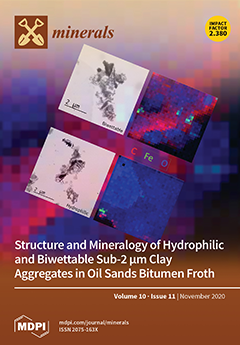Checking the presence of sesquioxide (Fe
2O
3, Al
2O
3) is helpful for its removal in advance. Therefore, the occurrence of sesquioxide in a mid-low grade calcareous-siliceous collophane ore (massive carbonate-apatite, also known as francolite) from Guizhou, China
[...] Read more.
Checking the presence of sesquioxide (Fe
2O
3, Al
2O
3) is helpful for its removal in advance. Therefore, the occurrence of sesquioxide in a mid-low grade calcareous-siliceous collophane ore (massive carbonate-apatite, also known as francolite) from Guizhou, China was determined by X-ray fluorescence spectroscopy (XRF), X-ray diffraction (XRD), field emission scanning electron microscope-energy dispersive X-ray spectrometry (FESEM-EDX) and Mineral Liberation Analyzer (MLA). The results show that iron mainly occurs as pyrite FeS
2, goethite FeO(OH) and as substitution within dolomite Ca(Mg,Fe)(CO
3)
2, while aluminum is enriched in muscovite KAl
2(AlSi
3O
10)(OH)
2 and also found in apatite (F,CO
3)CaPO
4 and calcite CaCO
3 due to isomorphism or adsorption. All these minerals are fine-grained, among which pyrite and goethite tend to be enriched in larger particles. Intergrowth is predominant in the six minerals’ locking. Pyrite is mainly intergrown with calcite, biotite and also included in apatite and muscovite, while the monomer pyrite appears as semi-automorphic fine grain with the liberation of 56.1%. Apatite particles are mainly intergrown with quartz and calcite. Most of goethite, dolomite, muscovite and calcite form intergrowth with apatite, with contents of 21.7%, 11.1%, 19.5% and 41%, respectively. The removal of pyrite, goethite, dolomite, muscovite and calcite in the ore is the key to reduce the contents of Fe
2O
3 and Al
2O
3. In the subsequent beneficiation, the ore must be fully ground. In addition to flotation, magnetic separation can also be considered to remove part of iron in ore. For the removal of aluminum from apatite, leaching method can be considered.
Full article





